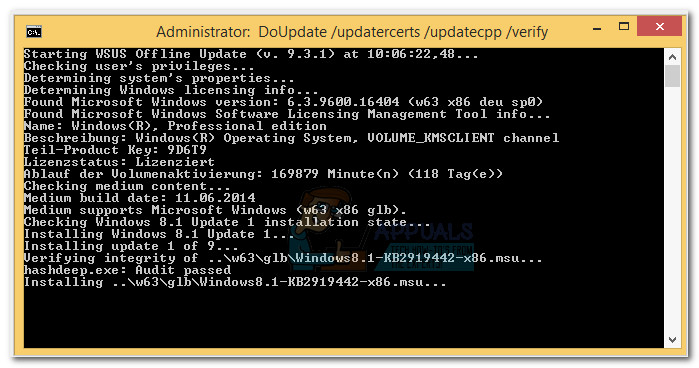Solved: Windows Update Standalone Installer is stuck
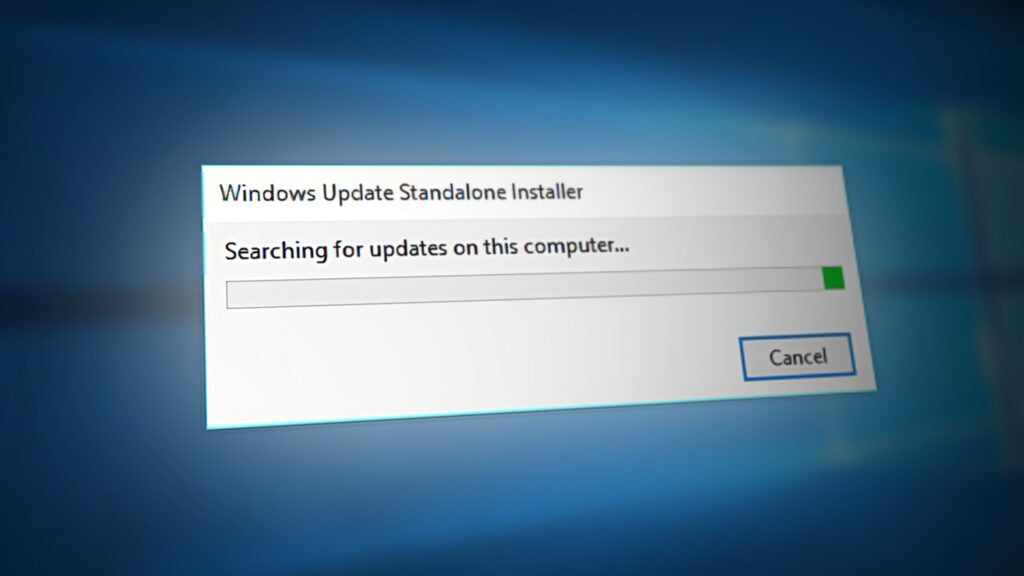
Users encountering the “Windows Update Standalone Installer stuck at searching for updates” issue reported that the search through the Windows Update Standalone Installer takes a lot of time (several hours) or gets stuck indefinitely. Another symptom of this issue is the Svchost.exe process having consistently high CPU & RAM usage. The appearance of this issue can be dated back to the 2nd quarter of 2016 and is confirmed to appear on Windows Vista, Windows 7 And Windows 8. This behavior is typically encountered after a clean OS installation or after an upgrade from an older Windows version. Up until now, Microsoft hasn’t provided a “works-for-all” solution that would aid end-users in encountering this problem.
Confirming that the system has this particular problem
Before you jump to the potential fixes below, it’s important to make sure that your computer is actually suffering from this issue. The updating component can glitch for a lot of different reasons, so it’s important to determine if the methods featured in this article will be effective in solving your Windows Update problem. Follow the steps below and see if your computer is having the symptoms related to this particular issue:
- Open Task Manager (Ctrl + Shift + Esc), go to the Processes tab and click on Show processes from all users.

- Go to the Services tab and click on the service called Wuaserv to highlight it. Then, right-click on it and choose Go to Process. Task Manager should automatically re-open the Process tab and highlight the Svchost.exe process associated with the Windows Updates.

- Spend some time monitoring Svchost.exe and see how it behaves. If you see that the process has consistently high CPU & Ram usage (around 200 MB), there’s a high chance that your computer is suffering from this particular issue. Consequently, the methods below should enable you to apply the missing updates and reduce resource usage.

If you confirmed that your computer is suffering from the same symptoms, you can proceed with the potential fixes below. Please follow the two methods in order until you encounter a fix that works for your situation.
Method 1: Updating via the most recent Servicing Stack Update (SSU)
Microsoft is aware of this problem and offers a somewhat effective fix with the KB 3102810 update. This particular Windows Update issue can usually be remedied by downloading the most recent Servicing Stack Update (SSU). However, updating via the SSU will not work unless the user has disabled Automatic Updates. Follow the steps down below to turn off Automatic Updates and update via the most recent Servicing Stack Update:
Note: The steps (and screenshots) below were created with Windows 7 in mind. Use the Note paragraphs under each step for the exact Windows 8 instructions and paths.
- Acess the start menu (bottom-left corner) and type “windows update” in the search box. Then click on Windows Update in the Program list above.
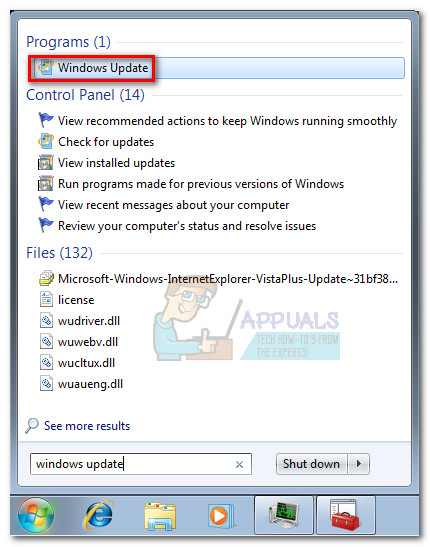 Note: On Windows 8, you can press the Windows key + I, then choose Control Panel from the newly appeared menu. In Control Panel, select Windows Update from the list.
Note: On Windows 8, you can press the Windows key + I, then choose Control Panel from the newly appeared menu. In Control Panel, select Windows Update from the list. - In the left pane of Control Panel, click on Change Settings, then set Important Update settings to Never check for updates. Hit OK to confirm your changes.
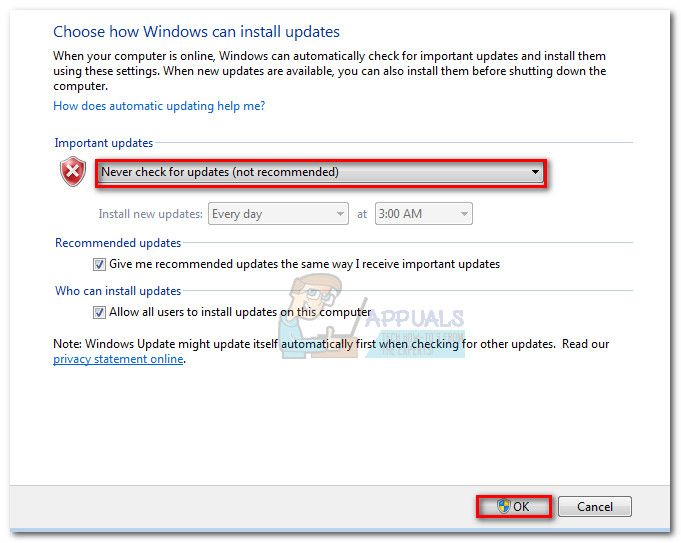 Note: On Windows 8, click on to Change Settings and set the settings for Automatic Updates to Never.
Note: On Windows 8, click on to Change Settings and set the settings for Automatic Updates to Never. - Restart your computer and wait for it to boot back up.
- Use this Microsoft link (here) to download the appropriate version of the SSU updated for your operating system. You can find the download links under Method 2: Microsoft Download Center.
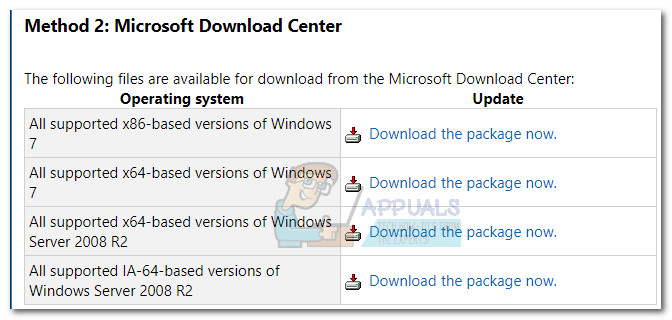 Note: On Windows 8, visit this official Microsoft link (here) and download the appropriate SSU driver based on your Windows version from under Method 2: Microsoft Download Center.
Note: On Windows 8, visit this official Microsoft link (here) and download the appropriate SSU driver based on your Windows version from under Method 2: Microsoft Download Center. - Install the SSU update and restart your system again. Then, return to Automatic Updates as we did in step 2 and re-enable Automatic Updates by setting them back to Install updates automatically.
- Finally, click Check for updates again in the Windows Update dialog box. The remaining updates should now install without issues.
 Method 2: Updating via WSUS Offline Updater
Method 2: Updating via WSUS Offline Updater
If the method above has failed, you’ll probably be able to install all the missing Windows updates by using WSUS Offline Updater. WSUS Offline Updater is a light-weight, open-source software that will automatically pull the missing updates from Microsoft servers and install them on your system.
This software will work on Windows 7 and Windows 8.1. Follow the guide down below to download the missing Windows updates with WSUS Offline Updater:
- Visit the official page of WSUS Offline Updater (here). Navigate to the Download page and download archive by clicking on the version number under Most recent version.

- Open the wsusoffline.zip archive and extract its contents into a drive that has enough space.
- Run the UpdateGenerator executable and check the boxes next to Verify downloaded updates and Include C++ Runtime Libraries and .Net Frameworks. Hit Start to begin downloading the missing updates.
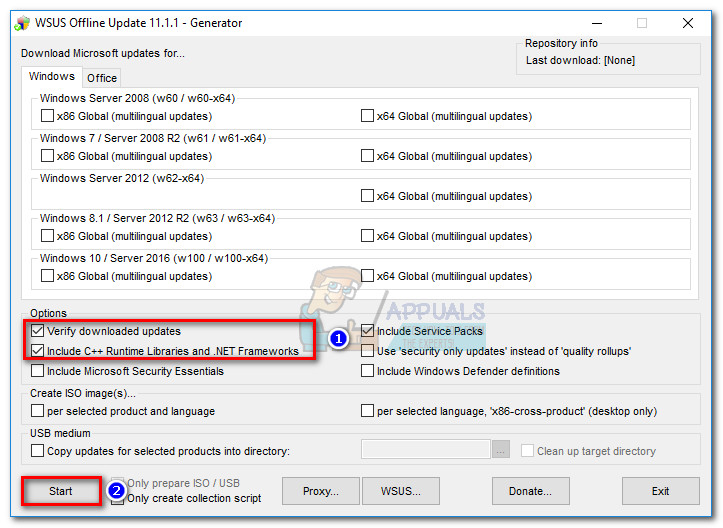
- Once the downloading part is over, close UpdateGenerator.exe and start UpdateInstaller.exe from wsusoffline > client folder.
- Finally, check the box next to Update C++ Runtime Libraries and hit Start to apply the updates to your computer.

- Depending on how many updates you have pending, this process can take over an hour. Once all updates have been applied, reboot your computer and enjoy your up-to-date Windows version.
